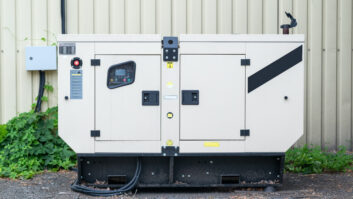This is the fourth in a series of articles about FM transmission systems.
The bandwidth of a commercial FM broadcast signal, depending on whether or not subcarriers are used, is about 260 kHz. This figure is representative of a carrier modulated 110 percent (or 82.5 kHz deviation), the maximum allowed under 47 C.F.R. §73.1570(b)(2).
The term “VSWR bandwidth” generally is defined as that bandwidth over which the antenna system has a VSWR of 1.1:1 or less (5 percent reflection coefficient). The antenna system includes the radiating elements, the interbay transmission line, matching devices and the transmission line. VSWR bandwidth generally is measured at the input to the transmission line (or the output of the transmitter).
Too often, FM antenna systems are tuned with the engineer watching the transmitter reflectometer while the tower worker adjusts the matching device on the tower. While this should result in the lowest attainable VSWR at the carrier frequency, it does not address the VSWR at the sidebands. Higher values of VSWR at the sideband frequencies or an asymmetrical passband will result in all sorts of undesirable effects.
Imperfect load
Synchronous AM is one such undesirable effect of narrow VSWR bandwidth and/or asymmetrical passband.
Consider a system that exhibits a very low VSWR on carrier and higher VSWR values at the sideband frequencies. As the carrier is modulated and power shifts to the sidebands, the perfect center-of-channel load presented by the antenna system becomes a much-less-than-perfect load at the sideband frequencies.
Final amplifier tuning is no longer optimal and a significant amount of power is reflected from the antenna system back to the final amplifier. The result is a change in the otherwise constant amplitude of the FM carrier with modulation, or amplitude modulation. The phenomenon is called synchronous AM because the amplitude modulation occurs synchronous with the FM modulation of the carrier.
Other signal problems caused by narrow VSWR bandwidth or asymmetrical passband are reduction in power amplifier efficiency, intermodulation distortion and stereo crosstalk. The greater the deviation, the worse the resulting signal degradation. Sometimes, such signal anomalies are identified incorrectly as multipath, when in reality they originate in the transmitter and antenna system. Needless to say, it is highly desirable to maintain good VSWR bandwidth.
As suggested above, the antenna and transmission line must be viewed and treated as a system rather than discrete elements, in much the same way as the phasing and coupling system along with the towers themselves are treated as a system in AM directional work. Each has an effect on the other. The longer the transmission line, the greater the effect it will have on the performance of the antenna system, and not only in the area of losses.
Long transmission lines introduce considerable phase delay in the transmitted signals. While that is not a problem with respect to the power traveling from the transmitter to the antenna, it is a problem when power is reflected back to the transmitter from the antenna.
The reflected power is delayed en route back to the power amplifier, where it recombines with the energy coming out of the power amplifier. It doesn’t take a lot of imagination to see how an on-channel signal with an unknown phase relationship and instantaneous deviation can muck up an FM signal.
Accurate evaluation
Because of this delay effect, with long transmission lines it is even more important to maintain good VSWR bandwidth. In fact, some engineers insist on sideband VSWR of 1.08:1 or less out to 130 kHz either side of the carrier in situations where long transmission lines are employed.
I mentioned above the reflectometer method of tuning an FM antenna. A much better method employs a signal generator and impedance bridge. An even better method makes use of a network analyzer. It is only by making an impedance sweep of the entire passband and plotting the results on a Smith chart can one accurately evaluate the overall VSWR bandwidth and performance of an antenna system.
Without specialized test equipment available, it is sometimes possible to get at least a rough idea of the VSWR bandwidth of an antenna by observing the screen current in the power amplifier. Screen current in some amplifier designs is a direct indicator of amplifier loading. Modulation activity in the screen current often is an indicator that VSWR bandwidth is less than optimal.
Checking synchronous AM noise is another good indicator, provided that it is known that the transmitter tuning (especially in the IPA and PA grid) has been adjusted for minimum synchronous AM.
In our next installment, we will examine the various designs of FM antennas commonly used along with their advantages and disadvantages.







